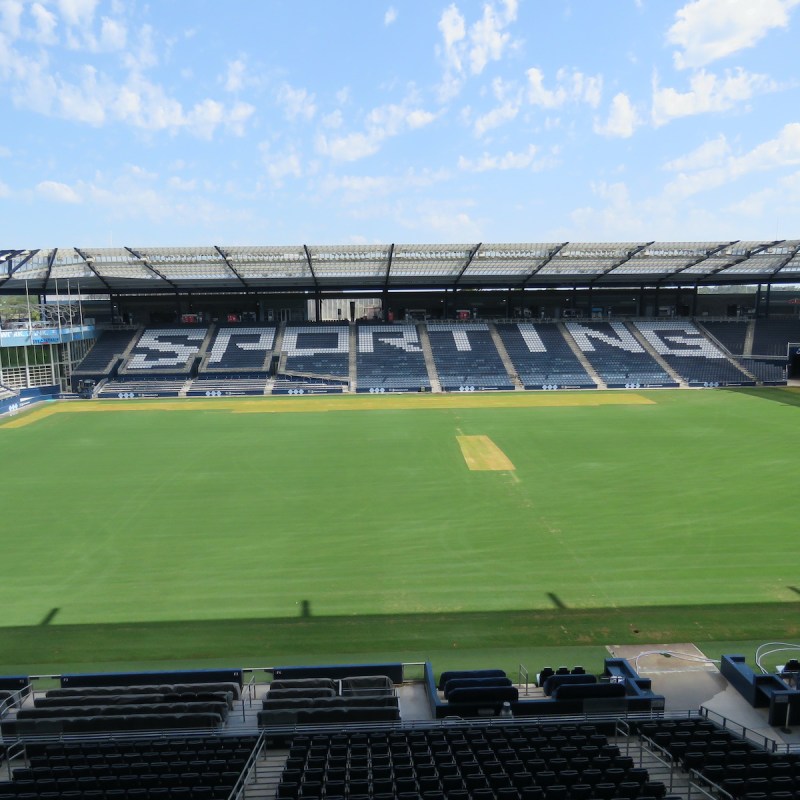
Kansas City, Kansas — KCK to locals — prides itself on being a city of diversity. With several prevalent ethnic groups, you’ll find plenty of attractions and restaurants that appeal to a variety of tastes. Visiting the Kansas side of the Missouri–Kansas border takes you on a path of cultural and historical diversity.
Videos by TravelAwaits

1. Historic Murals
Downtown Kansas City features impressive murals exploring the city’s history and culture, but you’ll find dozens more scattered around town.
Possibly the largest and most grandiose art piece in the city may be the Anthology of Argentine Mural in the Argentine neighborhood. Tracing the immigrant history of Kansas City, the block-long mural, painted on a tall brick wall, first honors the Indigenous peoples who lived in the area before Euro-American immigration, followed by other ethnic groups. The mural features a collage of cultural activities and events, including a local band, Latino wrestling, the growth of the railroad, and dancing.
Downtown’s Avenue of Murals highlights the area’s history, including the local newspaper, Hmong community, Native Americans, and Hispanic influence.
2. Strawberry Hill Museum And Cultural Center
Built in 1887, the Queen Anne–style mansion was built for the Scroggs family. After the Scroggs lived in the home for more than 20 years, a local parish bought the mansion and turned it into an orphanage for scores of children who lost their families during the 1918 flu pandemic. The church ran the orphanage until it closed in 1988, and sold it to a Strawberry Hill historical group.
Today, the Strawberry Hill Museum And Cultural Center explores the European immigration to the area, including several Eastern European countries, such as Croatia, Russia, Slovakia, and Poland. Western European immigrants came from nations such as Denmark and the Netherlands. The museum took its name from the neighborhood, whose hills were once covered with strawberry vines.

3. Wyandot National Burying Grounds
Formerly the Huron Indian Cemetery, the burial ground is a major story in the history of the Wyandot following their forced relocation to the area from Ohio. The Wyandot National Burying Grounds offer a historical and picturesque look at the Native American nation through its gravestone designs and the noteworthy people buried there, including a chief and Eliza (Lyda) Conley, the first Native American lawyer to argue a case before the United States Supreme Court. While she lost the 1910 case, Conley won in the end, as a state law was passed to protect the then–Huron Indian Cemetery from being razed for business development. Conley is buried there, alongside her family.

4. Grinter Place — Kansas Historical Society
Grinter Place gives a glimpse into rural life during the mid-1800s. Moses Grinter made a living during the 1830s running a ferry crossing the Kansas River for soldiers assigned to Fort Leavenworth and Fort Scott, before opening a successful trading post. The Grinters built their second home — and the first farmstead in the county — in the late 1850s. The Grinters also invested in real estate, buying land from local Native Americans.
While Moses received credit as a successful businessman, several people believe it was Annie who was the brains behind their real estate ventures. As a Native American (she was a member of the Delaware tribe), Annie Grinter couldn’t be seen as the face of the business. Visitors learn these and other tidbits during a tour of the two-story house. The home includes furniture and accessories common to the era the family lived there, as well as some family items. The farm is located on a hill and offers a picturesque view of the area.

5. Wyandotte County Historical Museum
Located inside a contemporary-looking building, the Wyandotte County Historical Museum provides a fascinating look into the area’s history. Combining vintage photos of the Quindaro ruins — once a community used to help freedom seekers on the Underground Railroad and later home to formerly enslaved people — with artifacts and memorabilia, the museum highlights key periods in Kansas City’s history.
One room focuses on Indigenous tribes that once lived in the area. While some are no longer in existence, the museum looks at tribes, such as the Kansaa (Kaw) and others, forced to relocate from the region.
Sculptures from classic buildings were saved before their demolition and can be viewed. Kansas City’s first fire department is prominently celebrated. A medical section includes a look at nursing in the area.
6. National Agricultural Center And Hall Of Fame
Explore the history of farming at the National Agricultural Center and Hall of Fame. With tractors, implements, and other farm machinery on display inside a Quonset building, the building gives a vibe of farm life. Take a walk through time as you visit a living history farm outdoors. Learn about key players from agriculture’s history with a visit to the Wall of Fame. The agricultural center also hosts special exhibits.
Pro tip: The National Agricultural Center is open seasonally, from April to October.

7. Kaw Point Park
Stand at the confluence of the Kaw and Missouri Rivers, near where the Lewis and Clark Corps of Discovery spent a few days during their exploration upriver. Kaw Point Park offers a beautiful view of the Kansas City, Missouri, skyline. The city park features a walking trail with wildflowers and native plants that the expedition may have seen. An amphitheater near the rivers includes stone seats with the names of the people (and Seaman, the Newfoundlander dog) who served with the Corps of Discovery. A parade ground includes the names of 17 tribes that called Kansas home. Tribal flags are flown during special events. The park is an excellent spot for dropping canoes and kayaks into the river.

8. Military Memorials
Kansas City honors its veterans with beautiful monuments. The Rosedale Memorial Arch is located on a hilltop, offering an impressive view of the Missouri side of the border. Resembling the Arc de Triomphe in Paris, the Rosedale Arch recognizes people who served during World War I. A smaller memorial is located beneath the arch honoring locals who served during World War II, Korean War, and Vietnam.
The Soldier and Sailor Memorial Hall in downtown KCK was built during the 1920s to honor those who served during World War I. But plaques and other exhibits in the lobby recognize Kansas Citians who have served in several wars, including World War II. Today, the building hosts community events and concerts. The facility hosted Patsy Cline’s last concert before the country music star died in a 1963 plane crash.
A monument thanking locals involved with building B-25 bombers during World War II is located outside the Wyandotte County Museum. It recognizes more than 50,000 people who built about 6,000 planes at the KCK plant. A portion of a plane can be seen inside the museum as part of military exhibit.
The Korean-Vietnam Veterans Memorial pays tribute to men and women who served during two of America’s post-World War II wars. The Korean-Vietnam Veterans Monument showcases major differences in the wars, with the Korean War statue featuring a soldier in a traditional 20th century military combat uniform. The Vietnam sculpture shows the influence of jungle fighting during the second-longest war in American modern history.

9. Quindaro Ruins Overlook And Museum
The small town of Quindaro served as a key stop in Kansas for escaped slaves as part of the Underground Railroad. In 1862, most residents had left the town, as men enlisted in the army and families moved to other communities. Abandoned buildings fell into ruin, and trees and vegetation covered them. A university opened in the area during the 1890s but closed during the Great Depression. Quindaro Ruins Overlook provides a view of the valley where the town once existed. The Old Quindaro Museum offers a look into the area’s history. You’ll also find a statue of abolitionist John Brown near the museum.
10. Sporting KC Stadium Tour
You don’t need to be a fan of soccer (or fútbol, as Ted Lasso might call it) to enjoy a tour of Children’s Mercy Park, home of Major League Soccer’s Sporting Kansas City. The team plays in the top soccer league in the United States. During a guided tour, visitors can check out the field up close, while also learning about the team and the game. Tours include a look at the team’s locker room and media center. Check out the scarf displays in the lobby, and learn their role in the sport.
11. Where To Shop
Part-tourist attraction, Legends Outlet Kansas City quickly grew from a few outlet stores to one of the Kansas City Metro’s most popular shopping destinations. With outlets such as Banana Republic, Gap, and Nike among the more than 75 national and local stores, Legends Outlets offers a full day of shopping, entertainment, and dining.
While there, explore the Kansas history trail, featuring sculptures and medallions recognizing such noted Kansas figures as Wyatt Earp, Amelia Earhart, Walter Chrysler, and athletes Wes Santee, Jim Ryan, and Maurice Greene (once considered the world’s fastest man).
Village West grew up around the outlets and is now home to stores such as NFM, Cabela’s, and Russell Stover’s, as well as Hollywood Casino and the Kansas Speedway.

12. Where To Eat
A diverse population creates an opportunity for outstanding ethnic food in KCK. Whether it’s Italian, Asian, or American fare — including the barbecue the area is famous for — you’ll find plenty of choices. If you want to challenge your taste buds, explore Kansas City’s Taco Trail, with more than 50 stops.
Further Reading:
